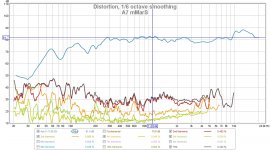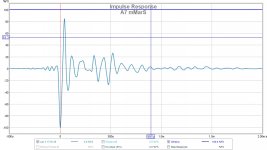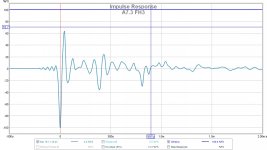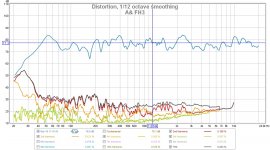Chris, its fantastic that Mark does that, but he is bound to a higher ethical standard than any DIYer. I can trash peerless, scan speak, eminence, you name it all I want. They're more than welcome to come here and defend their products. Mark chooses to step out and engage, and that's great. But if a scan speak engineer can here and said "what do you DIYers know about mid woofers" I'd take issue with that. If another DIYer said "what does tux know about mid woofers" I'd blow it off. manufacturers and users are on different ethical levels and that seems to be forgotten with Mark.
I dare Mark or anyone else to find a post of mine where I have criticized his product without warrant. I have on a number of occasions criticized his measurements. I've also criticized measurements by other manufacturers. In fact, I've even recommended his products, recently!! And not just on this forum!!!! Just a couple days ago I suggested someone look into MA drivers for a desktop setup over on AVSforum.
So I state my case, this isn't a matter of Mark bashing, this isn't me hoping Mark is run out of business (as he seems to think is the case based on his post on his forum), this isn't about how his drivers sound. This is ALL about his measurements and his attitude towards DIY measurements which have been consistently negative for as long as I've had an interest in his products. If his measurements aren't reliable, who is he to say one way or the other how a DIYer should do theirs.
I dare Mark or anyone else to find a post of mine where I have criticized his product without warrant. I have on a number of occasions criticized his measurements. I've also criticized measurements by other manufacturers. In fact, I've even recommended his products, recently!! And not just on this forum!!!! Just a couple days ago I suggested someone look into MA drivers for a desktop setup over on AVSforum.
So I state my case, this isn't a matter of Mark bashing, this isn't me hoping Mark is run out of business (as he seems to think is the case based on his post on his forum), this isn't about how his drivers sound. This is ALL about his measurements and his attitude towards DIY measurements which have been consistently negative for as long as I've had an interest in his products. If his measurements aren't reliable, who is he to say one way or the other how a DIYer should do theirs.
Some recent measurements of A7.3 by BMS:
http://www.diyaudio.com/forums/full-range/249984-cheap-fast-ob-literally-28.html#post3881836
http://www.diyaudio.com/forums/full-range/249984-cheap-fast-ob-literally-28.html#post3881836
Some recent measurements of A7.3 by BMS:
http://www.diyaudio.com/forums/full-range/249984-cheap-fast-ob-literally-28.html#post3881836
Not that I have a problem with the measurements per se -- they are pretty much what I would expect, I have an issue with technique.
It is really bad practice to use a speaker as a stand for another speaker, particularly with the driver facing the microphone. It is easy to get sympathetic vibrations that can muck up the measurements.
Bob
Member
Joined 2009
Paid Member
He just deleted the post for no given reason.
I have found that many of the commercial forums are places where you have to tread on egg shells.
I had a similar experience over on Greg Ball's forum recently. He released his schematic and I designed and built a superb surface mount PCB. I posted it in his forum in the thread dedicated to others building his amp. He deleted all my posts pronto without reason.
What do we learn from all this - DON"T TURN A HOBBY INTO A BUSINESS if you want to continue to enjoy it and talk freely about it !
p.s. I built a pair of Pensils with the A10.3 for a friend last year - these are the best full range drivers I have ever heard for clarity, imaging, dispersion and coherence, just simply superb (I've heard Fostex FE127, EL70, AN15).
Last edited:
I don't think it's a matter of treading on eggshells as much as appreciating that they are commercial. The commercial forums have been paid for by the various manufacturers / whatever, and are not the same as the open DIY forums such as this one. In general, they exercise far tighter control over what is posted on their forums, and if they deem something is not in their interest, they may well delete it. Simple as that. Personally, I don't think the demarcation between the open & commercial forums is as clear as it needs to be, since different mind-sets are generally required, but what the solution is, I don't know. What I do 'know' (well, I don't actually know, but I have a suspicion) is that like it or not, the commercial boys are probably needed to ensure the survival of the forum as a whole. Forums like DIYaudio.com don't come cheap.
Last edited:
I had no idea that the commercial forums were paid for, I just thought they were done as a courtesy towards the manufacturers as a way of increasing traffic for the website whilst also providing a legitimate place for people with commercial interests to post.
That said, the attitude of the manufactures towards postings, changes quite dramatically from forum to forum. This makes it hard to know what is okay or not okay to post. The way the guys from Twisted Pear handle their moderation is quite different from how Mark does. Mark appears to simply delete anything that could be construed as negativity towards his drivers, even if you're actually trying to be constructive in your criticism. Or rather when you simply want to discuss objective stuff, backed up by scientific reasoning and understanding - ergo without any kind of apparent agenda - it makes no difference. He simply tries to dismiss you and if you push the issue you're seen as having something against MA and boom, deletion.
I think treading one eggshells is a very appropriate comment.
Even over at the Acoustic Elegance forums people have posted threads questioning certain aspects of their drivers, where they are then met with technical discussion. Then if the threads aren't completely resolved they are simply left, even if it counts against them and certainly aren't deleted out of hand.
That said, the attitude of the manufactures towards postings, changes quite dramatically from forum to forum. This makes it hard to know what is okay or not okay to post. The way the guys from Twisted Pear handle their moderation is quite different from how Mark does. Mark appears to simply delete anything that could be construed as negativity towards his drivers, even if you're actually trying to be constructive in your criticism. Or rather when you simply want to discuss objective stuff, backed up by scientific reasoning and understanding - ergo without any kind of apparent agenda - it makes no difference. He simply tries to dismiss you and if you push the issue you're seen as having something against MA and boom, deletion.
I think treading one eggshells is a very appropriate comment.
Even over at the Acoustic Elegance forums people have posted threads questioning certain aspects of their drivers, where they are then met with technical discussion. Then if the threads aren't completely resolved they are simply left, even if it counts against them and certainly aren't deleted out of hand.
Not that I have a problem with the measurements per se -- they are pretty much what I would expect, I have an issue with technique.
It is really bad practice to use a speaker as a stand for another speaker, particularly with the driver facing the microphone. It is easy to get sympathetic vibrations that can muck up the measurements.
Bob
I gotta agree with Bob that BuildMeSomething's data is not useful here. The IR screams reflections or Bob's astute recognition of a symathetic vibration. Those peaks in the IR aren't from the box, they're far to strong.
To claim a manufacturer's data isn't reliable, I need to be confident the data is clean and accurate. That means well away from boundaries and windowed to remove the rest of the reflections if necessary. Otherwise Mark is right, we aren't at his level and can't make these claims.
I see the point about not having another driver nearby for the measurements but how much of an effect is that really? I have done measurements of the fullrange tops (as BMS) has also on an OB with the woofer right below in an inactive state. The impulse response and frequency response seem to be the same as when I measured it without the woofer directly below it. I think the reflections you see are so close they must be coming from internal reflections in the box and back out the cone. Perhaps more internal damping needed? I think the A7.3 if tested in the OB will not have the same early reflections.
BTW, a few days after this thread dropped off the front page I noticed on the A12p data sheet that the db scale is 20db and the -50db to 110db. I wasn't gonna raise the thread, but now that it is I gotta ask what does -50db sound like??? And how is a 160db range not considered smoothing?
I didn't check out some of the other data sheets of MA's, but wondered if me noting this would encourage him to bring his scales in line with other high end manufacturers like scan speak (5db and 50db range), Fostex (10db and 80db range, still to wide IMO), SEAS (5db and 50db range), Morel (5db and 60db range), etc.
I didn't check out some of the other data sheets of MA's, but wondered if me noting this would encourage him to bring his scales in line with other high end manufacturers like scan speak (5db and 50db range), Fostex (10db and 80db range, still to wide IMO), SEAS (5db and 50db range), Morel (5db and 60db range), etc.
I agree that a lack of consistency in the commercial sector forums can be a problem. Then again, since the commercial boys have paid for their forums, they have the right to run them in the way that they want & feel works for them, just as the manufacturer forums are done on Audiocircle & elsewhere. If a particular manufacturer's 'rules' don't suit, the best solution is not to post there.
I can't speak for Mark (or anyone else for that matter), but I suspect that his take essentially is that if he perceives (correctly or not: it ultimately makes no difference) something on his forum is not likely to be in his interest, then he will simply delete, and possibly, circumstance depending, delete all subsequent posts by the same person.
Perhaps the commercial forums could each have a sticky thread clearly stating their particular rules / boundaries / call them what you will. I suspect DIYaudio has a harder time than somewhere like AC because of the very name -originally it was set up as a DIY forum AFAIK, only later paid-for-commercial forums being added. And they're not the same; a clearer demarcation, as I say, seems to be needed, but how that could be implemented I'm not sure.
I can't speak for Mark (or anyone else for that matter), but I suspect that his take essentially is that if he perceives (correctly or not: it ultimately makes no difference) something on his forum is not likely to be in his interest, then he will simply delete, and possibly, circumstance depending, delete all subsequent posts by the same person.
Perhaps the commercial forums could each have a sticky thread clearly stating their particular rules / boundaries / call them what you will. I suspect DIYaudio has a harder time than somewhere like AC because of the very name -originally it was set up as a DIY forum AFAIK, only later paid-for-commercial forums being added. And they're not the same; a clearer demarcation, as I say, seems to be needed, but how that could be implemented I'm not sure.
This has gotta be a royal pain in the focused gap for all parties involved / interested .
If my understanding is correct, part of Mark's issue is the fact that the above mentioned "established / esteemed" manufacturers (to name a very small number) - have neither industry agreed upon standards for the conditions under which measurements are taken, or how they're displayed.
At the very least, that leads to "re-interpretation" / extrapolation, or simple wild-a$$ed speculations as to how measures not expressed to exactly the same "standards" (i.e. are there any?) represent what real world performance of different drivers will compare. Taking the conspiratorial approach that "these don't read like I'm used to / expect to see / measure myself, therefore they must either terribly flawed or intentionally distorted or both" doesn't really propel the conversation towards a well reasoned and objective conclusion, does it now?
If my understanding is correct, part of Mark's issue is the fact that the above mentioned "established / esteemed" manufacturers (to name a very small number) - have neither industry agreed upon standards for the conditions under which measurements are taken, or how they're displayed.
At the very least, that leads to "re-interpretation" / extrapolation, or simple wild-a$$ed speculations as to how measures not expressed to exactly the same "standards" (i.e. are there any?) represent what real world performance of different drivers will compare. Taking the conspiratorial approach that "these don't read like I'm used to / expect to see / measure myself, therefore they must either terribly flawed or intentionally distorted or both" doesn't really propel the conversation towards a well reasoned and objective conclusion, does it now?
Last edited:
BTW, a few days after this thread dropped off the front page I noticed on the A12p data sheet that the db scale is 20db and the -50db to 110db. I wasn't gonna raise the thread, but now that it is I gotta ask what does -50db sound like??? And how is a 160db range not considered smoothing?
I didn't check out some of the other data sheets of MA's, but wondered if me noting this would encourage him to bring his scales in line with other high end manufacturers like scan speak (5db and 50db range), Fostex (10db and 80db range, still to wide IMO), SEAS (5db and 50db range), Morel (5db and 60db range), etc.
I've suggested on multiple occasions over the past year that the vertical scale on the 12P data sheet should be significantly reduced, since leaves them wide open to 'attack' / accusations / complaints / insert preferred term. Others have mentioned it also in various places, so not actually news. I believe my term was 'you are asking for trouble' for the aforementioned reasons. In fairness, they're a very small company with a large workload & can't just drop things to re-do the measurements / datasheets. At present, about all you can say is that they are what they are & the scale is clearly stated, so we live with it. It's not the flattest of their drivers in FR terms, although it's my personal favourite of their units. I like the extra sensitivity / dynamic range, and it actually sounds rather neutral. Name your poison.
Last edited:
You're right that there is no set rules on how to display measurements. Mark is under no obligation to change his display. And there aren't even any rules on how to measure. Heck, SEAS doesn't even measure on an IB, they measure in a box, which actually makes them look worse than they are compared to the competition.
Despite this, there is a generally accepted and expected scale/range for most db axis. All I meant by that comment was that the measurement detail is lost on such a wide scale and moving closer to the competition would make this easier to read / understand, hopefully benefitting his customers. But hey, I doubt he cares what I think anymore
EDIT - the above was for Chris. Thanks Scott. I'm glad it's been noted before. So I take it it's only the 12p sheet that has this wide scale. I agree, it's asking for trouble. I've never seen a scale so wide, even on a DIY measurement
Despite this, there is a generally accepted and expected scale/range for most db axis. All I meant by that comment was that the measurement detail is lost on such a wide scale and moving closer to the competition would make this easier to read / understand, hopefully benefitting his customers. But hey, I doubt he cares what I think anymore
EDIT - the above was for Chris. Thanks Scott. I'm glad it's been noted before. So I take it it's only the 12p sheet that has this wide scale. I agree, it's asking for trouble. I've never seen a scale so wide, even on a DIY measurement
Ryan - my point was that as it's unlikely there will ever be identical conditions of test , absent the stipulation such the exact conditions (size and configuration of room / baffle / microphone distance(s) / polar angles / drive voltage/current levels, etc etc ) under which the measurements are taken, as well the amplitude scale / gating, smoothing, etc etc , must be expressed along with the published results, it becomes very hard for the average hobbyist to parse them all into something helpful in the decision making process.
I guess there's something to be said for just listening to it
And Mark does have other things on his plate than just what any of us here think or speculate on the open forums.
I guess there's something to be said for just listening to it
And Mark does have other things on his plate than just what any of us here think or speculate on the open forums.
I noticed on the A12p data sheet that the db scale is 20db and the -50db to 110db. I wasn't gonna raise the thread, but now that it is I gotta ask what does -50db sound like??? And how is a 160db range not considered smoothing?
No human knows since our range of perception in our most acute hearing BW is 'only' ~ - 35-40 dB depending on who you ‘ask’ and I assume why one 'wag' [I forget who] said that "HIFI begins at -40 dB".
AFA our hearing ability, -25 dB is pretty much it unless the source is very close, so to 'cover the bases', a good design noise 'floor' should be > -35 dB.
Our pain threshold is in the 120-130 dB range depending on frequency/individual, so I can’t say that a 160 dB scale is technically ‘smoothing’, but the pioneers chose 50-60 dB in 10 dB increments as sufficient resolution to give an accurate enough ‘sound picture’ of what they were hearing [or expected to hear in some cases] and I see no reason to use any wider.
For sure, I’ve no interest in a cone/dome driver, speaker that disappears off a +30 dB chart, so from this POV, a 160 dB range with 20 dB increments is grossly misleading IMNSHO.
GM
Just to keep perspective: every 20 dB is a factor of 10 and 160 dB range is 10^8 (or 1/10th of a billion) pressure range. I don't know too many instruments capable of that wide of a dynamic range except photon counters which can resolve single counts up to billions. But those are discreet event data - not continuous variations in a scalar.
Hi, as X has posted a reference to a few measures I did of the A7.3 in the mMarS sealed enclosure, thought I'd post them here properly and add some from the A7.3 I have also fitted in the FH3 enclosure.
I know Bob fretted about the mMarS sitting atop another speaker during measurement. With the possible early reflection being due to the woofer underneath... As shown, the A7 fitted FH3 has the same early reflection plus a second just after. Personally think these are due to internal reflections.
I want to measure the A7.3 fitted to an OB, I'm hoping that free of a box these will go beyond the -45dB to -50dB distortion figures they currently exhibit in the FH3 and mMarS enclosures.
Paul
I know Bob fretted about the mMarS sitting atop another speaker during measurement. With the possible early reflection being due to the woofer underneath... As shown, the A7 fitted FH3 has the same early reflection plus a second just after. Personally think these are due to internal reflections.
I want to measure the A7.3 fitted to an OB, I'm hoping that free of a box these will go beyond the -45dB to -50dB distortion figures they currently exhibit in the FH3 and mMarS enclosures.
Paul
Attachments
Last edited:
- Status
- This old topic is closed. If you want to reopen this topic, contact a moderator using the "Report Post" button.
- Home
- Loudspeakers
- Full Range
- MA driver measurements



